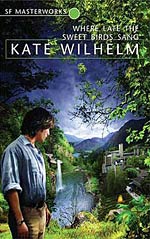
![]() Emil
Emil
1/10/2011
![]()
Like the Shakespeare sonnet (S 73) the title of the book is taken from, the novel's premise forces the reader to face the fatality of life. It is more allegorical than science fiction, written in a time of gas shortages and talk of a coming ice age where fervent supporters of zero-population growth abounded.
The novel is divided in three parts, the first almost a direct expression of our current times, producing an oeuvre of timelessness: droughts and floods, blighted crops, shortages, rampant diseases and plagues, worsened by escalating military action. And ultimately nuclear war, albeit limited. As a lethal plague spreads across the world, leaving survivors sterile, cloning is perfected as the ultimate survival strategy, with the over-arching goal being that the clones would be able to have children in the future. But the clones have other thoughts.
With the dependence on reproducing through cloning, other human traits and characteristics are lost - including the very abilities and talents that allowed the clones to be created. With each new generation the clones become more like facets of a single organism than individuals, sharing emotions and attitudes, all but eradicating those elements that are vitally important for human survival in a hostile world. When a child is born into the community as "a singular being", he becomes, for a short period, the salavation of the clones by helping them raid the dead cities for scientific materials. But ultimately his individualism is perilious to himself as it is to the community and both his and the community's survival is no longer certain.
This book is certainly worth reading! Apart from the obvious themes about the importance of individuality and creativity, there are the themes about encouraging the development of instinctual behavior, adaption, exploration (of new horizins) and a sense of comfort and cohesion with the natural world, providing an unhysterical reminder that to be human is to be unique and that to be different is sacred. Bear the context in mind: it's a cuationary tale of global pollution and human clones when those ideas were still new!
"If a new structure is to rise, it must start at the ground, not on top of what has been built during the centuries past."